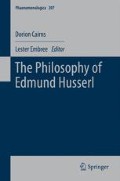Abstract
Translating Husserl’s Erlebnis as “awareness,” Cairns first describes how each awareness in a stream of mental life is aware of preceeding awarenesses, which it thus “retains,” and possible future awarenesses that it “protends” and then he describes the synthesis based thereupon whereby identical objects transcendent of mental life are also constituted. Appresentation as distinguished from presentation, the relation of mind and body, and other matters are also raised.
Access this chapter
Tax calculation will be finalised at checkout
Purchases are for personal use only
Notes
- 1.
At this point there is a “?” in the margin in the “A” version.” – L.E.
- 2.
Marginal Note: “Checked with original MS only to here: October 22, 1940. Continued, Feb. 6, 1954.” – L.E.
- 3.
Marginal Note: “Question marks referring to the previous phrase.” – L.E.
- 4.
Marginal note: “This seems to deny by implication that internal time is continuous. It has, I believe, no basis in Husserl—or in the phenomena.” – L.E.
- 5.
The point is singled out from the concrete extent by the epithets “ur-present” “ur-impressional.” (German “ur” is equivalent to Greek “proto.”)
- 6.
Strictly, of course, the consciousness is temporally modified and so retained, qua horizon and, with the consciousness, its inseparable object as intended.
- 7.
- 8.
The world “transcendent” is applied to objects that are not parts of consciousness. Thus, for example, Memorial Hall is a transcendent object, but the seeing or remembering of Memorial Hall is an immanent “object.” Objects of the latter sort are spoken of as immanent whether they be parts of psychological consciousness or parts of transcendentally reduced consciousness.
- 9.
A series of nine asterisks separate the following from what went before, but is not used again and is deleted here. – L.E.
- 10.
The usual connotation of the word “act” is misleading. Not all “acts” in Husserl’s sense are actions, activities, deeds, in the sense in which willing, deducing, and adding are actions. Though all the objects called acts have, as we shall see, characteristics which make the name not arbitrary, the description given above is the essential definition.
- 11.
Cf. p. 22.
- 12.
The precise definition of the act is not easy. Husserl, in the Méditations Cartésiennes, speaks of transcendental consciousness as a single act, in that it is a single synthetic unity, whose form is transcendental time. This synthetic unity includes, then, the acts of the transcendental onlooker as well as those executed in the natural attitude. The unity of the one act would be correlate of the unity of the ego, as subject of all its acts. The sense (of the word “act”) here involved differs, then, from the sense which we have defined. The latter, notwithstanding its discrepancy with this one passage, seems to be implicit in Husserl’s general use of the word, and hence has been used as the basis of our exposition. In either sense, the act is an important unity in transcendental consciousness; but only in the sense which we have defined, does it isolate unities for analysis.
- 13.
There is one type of exception to this: other transcendental streams of consciousness are intended by me as having each a distinct transcendental time-form immanent to itself, but transcendent of my transcendental consciousness. These transcendental times of other subjectivities are intended (intended in my transcendental consciousness) as outside world-time, just as the transcendental time of my own mind consciousness is.
- 14.
There is a question mark over the word “phase.” – L.E.
- 15.
Author information
Authors and Affiliations
Editor information
Editors and Affiliations
Rights and permissions
Copyright information
© 2013 Springer Science+Business Media Dordrecht
About this chapter
Cite this chapter
Cairns, D., Embree, L. (2013). General Nature of Intentionality. In: Embree, L. (eds) The Philosophy of Edmund Husserl. Phaenomenologica, vol 207. Springer, Dordrecht. https://doi.org/10.1007/978-94-007-5043-2_2
Download citation
DOI: https://doi.org/10.1007/978-94-007-5043-2_2
Published:
Publisher Name: Springer, Dordrecht
Print ISBN: 978-94-007-5042-5
Online ISBN: 978-94-007-5043-2
eBook Packages: Humanities, Social Sciences and LawPhilosophy and Religion (R0)

